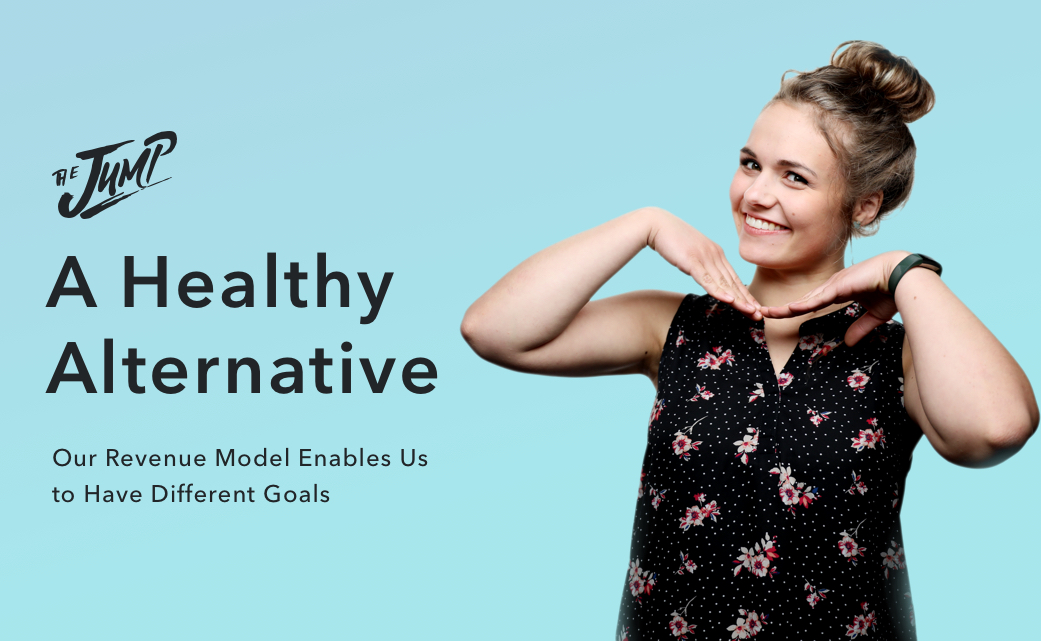Middle school and high school aged youth are constantly warned about the dangers of unprotected sex, drugs, and alcohol. But have you ever heard of a class for youth on proper social media use? A study by researchers from the University of Chicago suggests that such a class should exist. That’s because the study found that social media is actually more addictive than cigarettes and alcohol.
Why is social media so addictive?
The short answer: It was designed to be this way. Every social media company in existence (with the exception of The Jump) makes more money when people spend more time on their website. The longer users are on social media, the more digital ads they can be shown. The answer to this crisis is not to get rid of social media, but to use platforms that promote responsibility. Read on if you want to learn about the dangers of social media addiction and The Jump, which is a healthy alternative.
Social media companies are trying to addict their users
Facebook’s Founding President Sean Parker recently opened up about Facebook’s retention strategy.
In an unusually candid statement, Parker explained that the main objective while building Facebook was: “How do we consume as much of your time and conscious attention as possible?” That mindset led to the creation of features such as the “Like” button, because Facebook creators knew “Likes” would give users dopamine hits, encouraging them to post even more. “It’s a social-validation feedback loop,” Parker said, “…exactly the kind of thing that a hacker like myself would come up with, because you’re exploiting a vulnerability in human psychology. ..[Social Media] literally changes your relationship with society, with each other. … .
God only knows what it’s doing to our children’s brains
Parker is just one in the original generation of tech innovator’s to start questioning the ethics of the software that he helped develop. Recently, The Guardian published an article entitled ‘Our minds can be hijacked’: the tech insiders who fear a smartphone dystopia. The article profiled multiple founding designers of big tech who have since rejected the use of Facebook and Google products. The individuals profiled include:

Justin Rosenstein, the Facebook engineer who first created the “Like” button:
Rosenstein, “tweaked his laptop’s operating system to block Reddit, banned himself from Snapchat, which he compares to heroin, and imposed limits on his use of Facebook.”
Tristan Harris, a former Google employee, is now alerting people to the effects that big tech is having on them psychologically:
Harris said, “All of us are jacked into this system… All of our minds can be hijacked. Our choices are not as free as we think they are … A handful of people, working at a handful of technology companies, through their choices will steer what a billion people are thinking today
I don’t know a more urgent problem than this
It’s changing our democracy, and it’s changing our ability to have the conversations and relationships that we want with each other.”
Social media companies are successfully addicting their users
Companies like Facebook, Google, and Twitter have succeeded. The average person spends nearly nearly 2 hours per day on social media, which means that they’ll spend 5 years and 4 months of their life engaging with people on a screen instead of in real life. In that same time period, someone could run 10,000 marathons, walk around the world nearly twice, or travel to the moon and back 32 times.
Here’s a few more statistics that put the current crisis in perspective…
- There are 3.1 billion social media users worldwide. That’s 40.3% of the world’s population.
- Some teens consume up to 9 hours of social media per day.
- An estimated 210 million people suffer from social media addiction.
- Teens who spend 5 hours per day on their phone are twice as likely to show depressive symptoms.
- Young, single females are addicted to social media more than any other group.
- 71% of people sleep near their phone.
- 50% of people who drive while looking at their mobile device are checking social media.
- Over 240 Million Americans check Facebook daily. To put that number in perspective, there are only 329 Million people in the US.
- The social media addiction crisis is only continuing to get worse every year. If this issue remains unaddressed, social media companies will continue to thrive by exploiting psychological vulnerabilities in their users.

The Jump is different. We don’t use psychological manipulation to keep you on our app. Would we like you to use the app? Duh. Of course. But the app is meant to be used sparingly so that you can focus on connecting with people for real! The Jump is supposed to support what you are doing in real life, not draw you away from it.
Different revenue model
The Jump can afford to swim upstream because our revenue model is fundamentally different. Other companies make more money when they’re able to show you more advertisements. However, The Jump doesn’t make money from digital ads, which means that our goal is to give you the best product, not consume your time.
The Jump’s structure limits the potential for addiction
Internet addiction is one of the most dangerous forms of addiction because there is always more content that users can access. With a drug or alcohol addiction, there’s a limit to how much the addict can consume. Eventually, the addict is going to run out of money. Yet, on social media and the internet, companies like Google, Facebook, and Twitter are always working to fill a user’s feed with more content. The Jump is different because it has natural limits on the ability of users to find more content. The Jump is about connecting with real people, not wasting time. There are limits on how many authentic relationships you can have and therefore, there are limits on what you can do on The Jump.
Most other platforms cramp every post into one, centralized feed. This creates an endless, emotional rollercoaster — “someone had a baby!” “everyone is dying” “cute cats” “political rampage.” Conversely, The Jump has no centralized feed. Since content can only be posted by users that are members of a given jump, there isn’t an incessant supply of posts.
Additionally, The Jump doesn’t give users the ability to stalk one another. Facebook, Instagram, and other social media sites have devolved into spaces where people create profiles to advertise themselves to the world.
The Jump is about connecting, not showcasing a facade
As a result, if you look someone up on The Jump, you’ll only see their profile picture, their name, a one sentence note about them, and the jumps that they are apart of. This forces users to join groups in order to connect with other people.
Leslie Walker, a professor at the University of Maryland, defined a social networking addict as, “someone with a compulsion to use social media to excess — constantly checking Facebook status updates or “stalking” people’s profiles on Facebook, for example, for hours on end.” Yet, on The Jump, there’s no centralized feed and no ability to stalk other users. There’s built in limits on the exact functions that have oftentimes led to media addictions on other platforms.
So if you still want the benefits of social media without as many opportunities for addiction, try out The Jump. The Jump is a way to harness the positives of social networking while getting rid of the negatives.

Recent Comments